Salton
Sea International Bird Festival
Feb
18-21, 2005
Guide- Bob
Miller
Photographs from the 8th annual Salton Sea International
Bird Festival.

Click on
thumbnail pictures for full-sized shots.
Day 2 - Saturday:
Algodones Dunes Wilderness Area Tour (continued)
|

Blister Beetle
|
There is always something to see for those willing to look!
This Blister Beetle was on Popcorn Flowers or Forget-me-nots.
|
|
Round-tailed Ground-Squirrel can be fairly easy to see.
Other desert creatures like Kangaroo Rat, Packrat, Kit Fox, Coyote
and "Burro" Mule Deer are usually discovered through the
tracks they leave in the sand. |
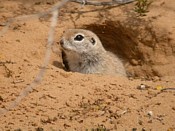
Round-tailed
Ground-Squirrel
|
|
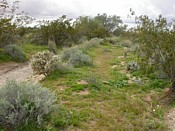
Algodones Dunes Wilderness
Area
|
Diamond and Buckhorn Cholla, Beavertail Cactus, Creosote, Galleta
Grass, Birdcage Primrose and Plantain are some of the native
plants visible in this pic but non-natives invasive species like
Shismus grass and Wild Mustard are prominent as well. |
| Robber Flies are fun and interesting to watch.
They are not really afraid of you so you can get pretty close.
They leave little star like prints in the sand and they catch and
eat insects like bees and large flies. |
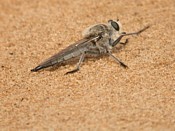
Robber Fly
|
|
Day 3 -
Sunday:
Algodones Dunes Wilderness Area Tour
|
It had rained all night Saturday and there was
just enough left at sunrise to let us know that we truly were
walking into a golden area. Few things in life thrill me as
much as water in the desert!
|
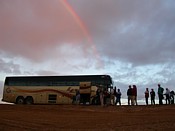
Anza Borrego Desert State
Park
|
|

LeConte's Thrasher
|
This individual LeConte's Thrasher sang from this perch non-stop
for several hours!! Beetles of all shapes and sizes can be found
out here. The number of species represented by the Darkling
Beetle family alone is amazing! I do not know what the
little golden haired beetle in my palm is. Any help?!
|
|
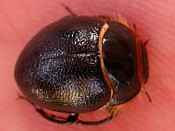
What is it?
|
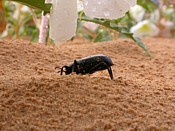
Darkling Beetle aka Stink
Bug!
|
|
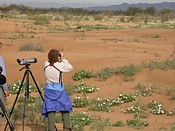
Dee
|
There was something new to be seen over every rise and behind
every plant. Distance is very deceiving in the desert. The Chocolate
Mountains are about 15 miles away in these pics.
|
|
That little
finger of a peak to the left is a prominent marker for desert rats
who know the area. There is a water source beyond it and
Native Americans traversed through there from the Colorado River
to ancient Lake Cahuilla that is now the Salton Sea.
|
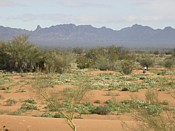
Chocolate Mountains
|
|